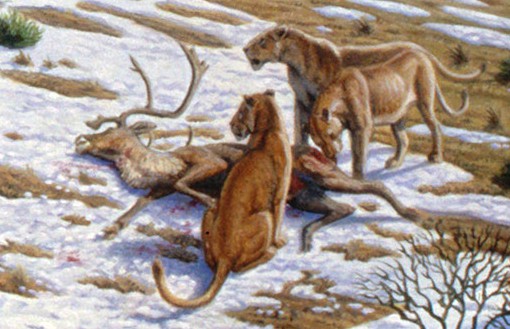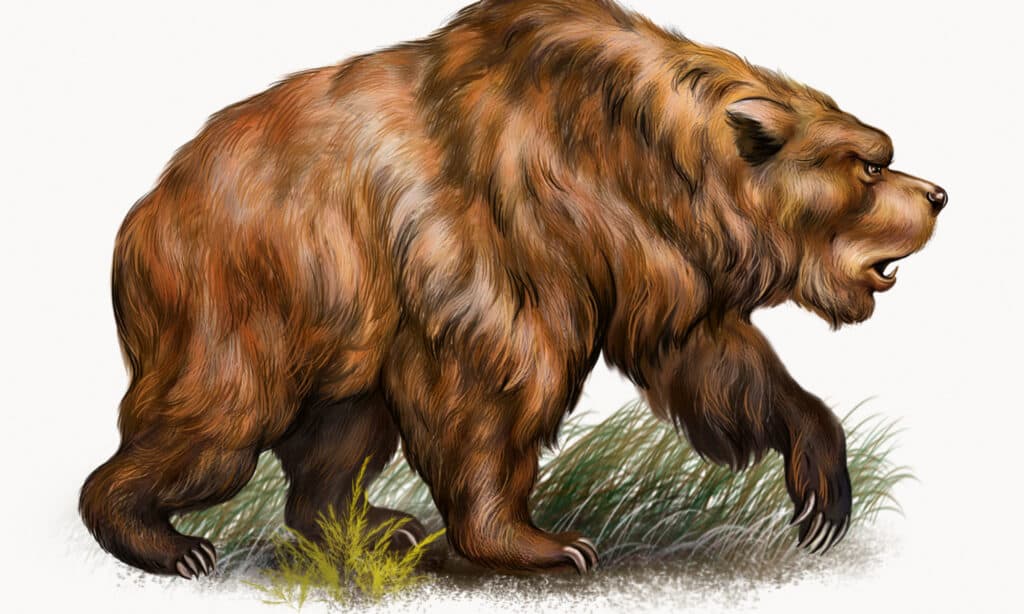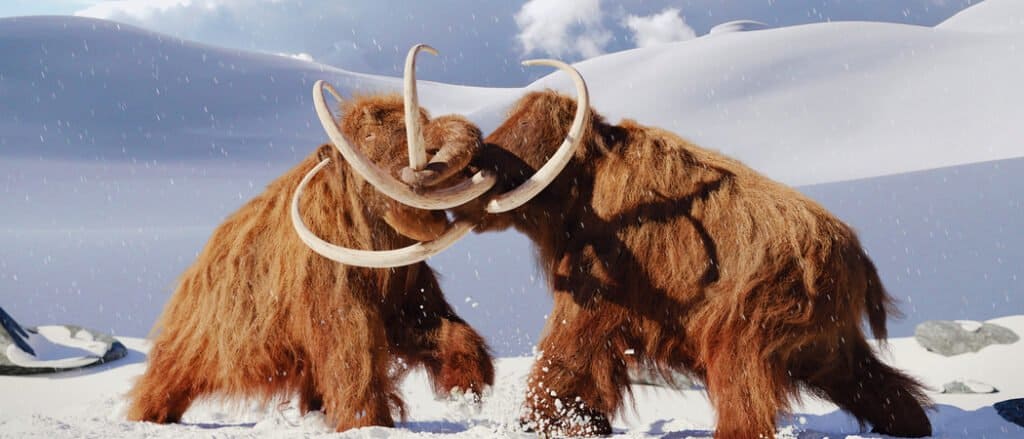Have you ever heard of the “Cave of Forgotten Dreams”? Officially known as the Chauvet-Pont-d’Arc Cave, the site is one of the most significant and well-preserved instances of prehistoric art ever discovered.
The images aren’t like the sketches and stick figures we normally associate with cave paintings. The paintings in Chauvet Cave are striking and detailed, and they give us insights into the inner and outer worlds of the ancient artists who made them.
Almost more breathtaking, though, is the fact that they were made by at least two great artists a few thousand years apart. This implies that the cave was occupied by humans for thousands of years and the images therein were never disturbed or altered by the people there.
So, these images were sacred to ancient humans as they are to us now. What can they tell us, though? What can we learn about the wildlife depicted in these paintings?
Let’s get some perspective on this mystical cave in southeastern France.
How Old Are The Paintings?
The first set of images was made 37,000-33,500 years ago, while the second was made some 31,000 to 28,000 years ago.
That’s more than 20,000 years before the Saber-Toothed Tiger went extinct. Woolly mammoths are thought to have died out around 4,000 years ago. Recently discovered fossilized footprints in New Mexico date to 23,000 years ago, pushing back science’s previous impression that humans crossed into North America 13,000 years ago so there’s a good chance that humanity hadn’t migrated across Eurasia and Beringia to reach North America yet.
The point is that the paintings in Chauvet Cave aren’t just old. They were made by someone who looked like you or me when the world was an entirely different place. The person who made the first set of images in this cave might well have known a Neanderthal or two, as that species died out roughly 40,000 years ago.
Paleolithic Art
Art from this period is known as “Paleolithic Art.” The Paleolithic period is also known as the Old Stone Age, and it encompasses the span of time that hominids were known to use stone tools.
Evidence of stone tool use ranges from over 3 million years ago up until the early Bronze Age around 12,000 years ago. The emergence of art in the Upper Paleolithic era is a hallmark for humanity, though.
40,000 years ago, around the time that these paintings were made, humanity started to make art that was figurative. This shift into figurative art is one of the metrics that historians use to mark “behavioral modernity.”
In other words, Homo sapiens earned the title of “modern humans” roughly 40,000 years ago. Prior to that, cave paintings, hand stencils, and other pieces of rudimentary art were being made for hundreds of thousands of years.
A lot of those older pieces are attributed to Neanderthals, and there’s even a 540,000-year-old carved shell attributed to Homo erectus. Another artifact known as Tan-Tan is thought to be 300,000 to 500,000 years old.
Tan-Tan is a rock that was naturally shaped like a hominid, potentially modified to look more like the individual who noticed it and picked it up. There are markings that suggest the rock was intentionally shaped to be more human-like.
Chauvet Cave’s Animals
Chauvet Cave depicts a number of animals, many of which aren’t on earth anymore. Numerous images show these animals interacting with one another, something that was unusual for the art of that period.
We’ll look at most of the animals depicted in Chauvet Cave, focusing on the animals that are now extinct.
Although it isn’t exactly clear, there are also a few images of animal-human hybrids and vague depictions that could be mystical inventions. One of the most notable aspects of the cave is now called the “Gallery of Lions.“
The Gallery of Lions
A section of the gallery contains an overlapping series of large lions. The lower section of the painting includes three massive lions, believed to be cave lions.
In total, there are five lions laid against one another, with one much smaller depiction that looks like a very young or adolescent cub.
Cave lions are also called “European cave lions,” and were one of the largest species of cats ever to exist. They fall into the Panthera genus, which is the same as modern big cats like tigers, lions, panthers, and leopards.
Remains of cave lions suggest that they were more than 10 feet long and would have occupied a top position in the food chain. They were either as big, or bigger than modern lions.
They get their name because their remains are mainly found in caves, although there isn’t a consensus on whether they lived in them. Apart from inferences made in response to skeletal remains, information about their appearances comes primarily from cave paintings like the ones in Chauvet Cave.
Two mummified cave lion Cubs, dated 28,000 and 43,000 years old, have also been discovered in excellent condition. You can see them here. They are two of the best-preserved Pleistocene specimens ever to be discovered.

Cave lions and
reindeer
were two of the many animals depicted by the artists of Chauvet-Pont-D’Arc Cave. (This is a modern artist’s rendering of those animals.)
©Mauricio Antón, CC BY 2.5, via Wikimedia Commons – License
Short-Faced Bears (Cave Bears)
There are numerous bears interwoven amidst the Gallery of Lions. Interestingly, the profiles of bears and lions are drawn closely together, potentially signifying their sister roles as apex predators.
The artist might have also noticed similarities in the appearance of cave bears and cave lions because it’s not immediately obvious which one is which. In any case, the paintings showcase numerous cave bears.
How do we know they were Cave Bears, specifically, and not just brown bears? Extremely well-preserved cave bear remains were discovered in the site cave the murals.
Some researchers think the remains were placed intentionally, and maybe even ritualistically.
Cave Bears certainly deserved respect, as they were a breed similar in nature to the largest Kodiac bears on record. They would have weighed somewhere in the ballpark of 2,000 pounds, stood 11.5 feet tall, and towered over the human inhabitants of Chauvet Cave.
Cave bears and cave lions both would have been familiar threats to the artists of the Cave of Forgotten Dreams.

There were two species of cave bear, both of which were the size of modern Kodiak and polar bears.
©Liliya Butenko/Shutterstock.com
Woolly Mammoths
Woolly mammoths are among the 430-odd ancient beasts charging through the mural (there are roughly 430 individual animals, the group is comprised of roughly 15 separate species).
In particular, there’s one depiction of a mammoth that deviates from what we know the animal actually looked like. This deviation implies that some artistic liberties might have been taken to fully capture the artist’s impression.
The legs are long, pinning up a relatively thin body that holds a large head with the characteristic mammoth skull and large tusks. At the bottom of its feet, there are little circles that could be representations of the hair that gathered at the bottom of some mammoths’ feet.
The body lacks hair, however. In this way, it appears more like an elephant at first glance, although the artists probably never saw elephants from their homes in southeastern France.
There is only one mammoth that shines through in the Chauvet Cave paintings. There is a lot of overlap and intertwining of images, so there’s no telling whether there were more mammoths in earlier renditions of the mural.
That said, it’s interesting to note that there is only one mammoth, whereas almost every other animal in the paintings gets represented numerous times.

Two woolly mammoths fight on the tundra
©Dotted Yeti/Shutterstock.com
Woolly Rhinos
Much of the remaining Paleolithic cave art is found in Europe. Woolly rhinos were very common in Europe 40,000 years ago, so these animals are one of the most common characters in cave paintings.
Woolly rhinos were distinct for a few reasons. For one, they had a prominent hump on their backs. Their backs were raised up high, and their heads hung down and bent low. They also had a thick coating of fur, most likely concentrating on their backs.
Some recreations of the woolly rhino show them with fur all over their bodies, although the numerous depictions in Chauvet Cave all show a distinct patch of dark hair in the middle of the back. A well-preserved woolly rhino carcass discovered in Siberia retained a lot of its thick coat, although that might have been an adaptation in the northernmost populations of these animals.
In any case, the rhinos in the cave have characteristic horns, with one drawing including numerous horns splayed back in repetition to create the feeling of movement. This is one of the most striking aspects of the entire cave.
At first glance, it looks like the artist just couldn’t get the size right so they drew the rhino and horn numerous times, getting smaller and smaller. Looking closer, though, we realize that they had the ability to erase mistakes with water and the repetition of the horn was certainly intentional.
Fighting Woolly Rhinos
Most ancient cave art depicts animals in an isolated way, with each figure hardly relating to the other figures around it. Chauvet Cave includes one of the earliest known images of two animals relating directly to one another.
The drawing shows two woolly rhinos facing each other and ramming, locking their horns together in a fight. These woolly rhinos locking horns illuminate the genius of the artists, who would never have seen an artistic depiction of two animals interacting before.
Elasmotherium
The multi-horned wooly rhino discussed above is distinct from every other in the cave. Its horn is more massive and the arch of its neck doesn’t include the same slope or form as the others.
There was another interesting relative of rhinos living in Eurasia at that time, although it would mostly have lived to the east of the people in Chauvet Cave. This animal was Elasmotherium.
Elasmotherium is believed to have had a massive horn, reaching a couple of meters long. It’s sometimes called the “Siberian Unicorn” for this reason. It’s conceivable to think that the artists’ community could have encountered one of these rhino-like ungulates.
It would have been rare, though, and Elasmotherium’s horn would no doubt have been an incredible, memorable sight. So, it’s possible that this central rhino figure with the impression of movement is a depiction of Elasmotherium, a species that’s estimated to have gone extinct around the same time the paintings were made.
Megaloceros Deer
Megaloceros means “Great Horn,” and is a fitting name for these massive deer that roamed Eurasia during the Pleistocene.
It’s also known as the Irish elk, although it didn’t necessarily contain itself to Ireland or have a relation to the modern Elk. It’s worth noting that the “European elk” is what people in North America refer to as the “moose.” So, when the Irish researcher who described the first discovered remains called it the “Irish elk,” he did so because he found horns that looked like they came from a Moose.
These animals probably stood at around 6 feet 8 inches at the withers (shoulder bone). The head would have stretched up another few feet.
Their horns, though, were a true spectacle, reaching across 12 feet from tip to tip. Megalocoros at least once in the Chauvet Cave.
The Reindeer Panel
Set aside from the main panel containing the Gallery of Lions, Woolly Rhinos, Mammoths, and Megaloceros, there’s another panel.
This panel contains a scene of mostly ungulates and individuals lower down on the food chain. There are five reindeer in the panel, surrounded by horses, aurochs, and bison. The direction of the animals switches randomly, giving the sense that they are all grazing in the same area.
That said, the various sizes and placements, particularly those of a horse head in the top center of the painting, give the image an abstract feeling rather than one of a realistic landscape.
Steppe Bison or Pleistocene Woodland Bison
The center of the painting features a number of well-detailed bison. These are situated in front of the Gallery of Lions, with all lions and bison facing the same direction. In this way, one could interpret the scene to depict a series of lions hunting the bison.
There are three potential subspecies of bison that the artists might have been depicting. It’s also possible that two or more bison species are represented in Chauvet Cave.
These are the European Bison, the Steppe Bison (last known from 5,400 BC to 7,000 BC), and the Pleistocene Woodland Bison (estimated to have gone extinct around 36,000 BC).
Some of the bison in the image do have different shaped heads which could denote different species or simply be representative of male and female bison of the same species.
The Venus & The Sorcerer
One interesting section of the cave is “The Venus & the Sorcerer.”
An outcrop of the cave shoots down and hosts the pubic triangle of a woman, made with charcoal and engravings. This only displays the pubic area and the base of the legs, with no feet or hips directly shown. This is known as the “Venus” and is a common symbol associated with the small statues and other engravings of the region from the same time period.
To the upper left, the towering profile of what is most likely a lion emerges from the torso of the woman. From the right, the upper body of a bison sits above the torso, forming a trifecta of images that could be interpreted in numerous ways. This bison is known as the “Sorcerer.”
In any case, researchers are sure that this was no accident and that the images were combined purposefully. One reason for this is that there is no imposition from any of the three images onto another. In other words, the lines don’t cross, but rather work together to form a singular image.
This is unusual because most of the other animal drawings are superimposed when there are numerous animals in one area.
There are at least four other depictions of similar pubic triangles placed at transitional points throughout the cave’s topography.
Who Painted the Cave?
There are many images in Chauvet Cave, some of which are faint or detectable only with advanced technology. So, it’s believed that numerous artists throughout millennia played parts in the paintings.
There are varying levels of skill and technique utilized in the images as well, so not all of the people who worked on the paintings were experts. Some would have been very unskilled although they were allowed to contribute to this great masterpiece.
The quality of some images, such as those in the Gallery of Lions, is so great that there must have been at least a few master artists working in the cave. These individuals advanced their craft, worked with numerous materials and did an excellent job of expressing themselves through their work.
The fact that select additions were made to the paintings over thousands of years could also suggest that only special individuals were allowed to make large contributions. This could be why there are only a few major aspects of the cave considered to be masterpieces.
We do know that the people who spent time in the gave were Aurignacians. They were a culture that used a variety of specialized tools and techniques. That use of tools could be what allowed them to refine their artistic craft to an extremely unique point for that period in time.
Want to Learn More About Prehistoric Life?
- 10 Extinct North American Mammals
- When Did Dire Wolves Go Extinct?
- Discover 6 Extinct Animals That Lived in Washington
- Meet the 8-Foot Giant Millipede That Once Roamed the Earth
The photo featured at the top of this post is © Mauricio Antón, CC BY 2.5, via Wikimedia Commons – License / Original
Sources
- Chauvet Cave, Available here: https://artsandculture.google.com/story/yQURd7pZumeaIQ
- Chauvet Cave, Available here: https://www.thoughtco.com/chauvet-cave-france-170488
- Paleolithic Beginnings, Available here: https://humanjourney.us/ideas-that-shaped-our-modern-world-section/paleolithic-beginnings/
- Tan-Tan: The oldest known human representation?, Available here: https://www.bradshawfoundation.com/sculpture/tan_tan.php
- Oldest Art Was Carved Onto Shell 540,000 Years Ago, Available here: https://www.seeker.com/oldest-art-was-carved-onto-shell-540000-years-ago-1769342728.html
- Cave Lion, Available here: https://www.newworldencyclopedia.org/entry/Cave_Lion
- 28,000-year-old cave lion cub found in perfect condition, Available here: https://thehill.com/changing-america/sustainability/environment/566611-28000-year-old-cave-lion-cub-found-in-perfect/
- Cave Bear Remains in Chauvet Cave, Available here: https://artsandculture.google.com/story/owWRJA5ZuHCZJA?e=StellaAccess
- The cave bear in Chauvet Cave, Available here: https://www.researchgate.net/publication/358045071_The_cave_bear_in_Chauvet_Cave
- Artists of the cave, Available here: https://www.britannica.com/topic/Aurignacian-culture
- Aurignacian culture, Available here: https://www.britannica.com/topic/Aurignacian-culture
- The Venus and The Sorcerer, Available here: https://bradshawfoundation.com/chauvet/venus_sorcerer.php
- Reindeer Panel, Available here: https://archeologie.culture.gouv.fr/chauvet/en/salle-hillaire-nord/notice/reindeer-panel
- A well-preserved woolly rhino with its last meal still intact found in the extreme north of Yakutia, Available here: https://siberiantimes.com/other/others/news/a-well-preserved-woolly-rhino-with-its-last-meal-still-intact-found-in-the-extreme-north-of-yakutia/
FAQs (Frequently Asked Questions)
What’s so significant about Chauvet Cave?
The significance of Chauvet Cave comes from the incredible preservation of its art. The images are still clear, probably in around the same condition they were in when the Aurignacians made them.
Further, the detail and craftsmanship associated with the images are unprecedented and unique.
Can you visit the real Chauvet Cave?
Visitors are not allowed in the actual Chauvet Cave. The cave has been preserved due to isolation and lack of exposure to the outside world. If people were allowed to enter en masse, the integrity of the images would be jeopardized.
You can visit an exact replica of the cave in southern France, however.
How old are the paintings in Chauvet Cave?
The paintings were made over a long period of time, spanning from roughly 28,000 years ago to 37,000 years ago, although there are a few thousand years for margin of error.
Thank you for reading! Have some feedback for us? Contact the AZ Animals editorial team.






